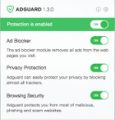What is MacWebService
MacWebService is a potentially unwanted application (PUA) that falls under the category of Adware. Adware is considered by many to be synonymous with ‘malicious software’. It’s a harmful application that presents unwanted ads to computer users. Some examples include pop up ads, different offers and deals or unclosable windows. Adware software can be installed onto your Apple Mac via infected web-pages, when you open email attachments, anytime you download and install freeware.
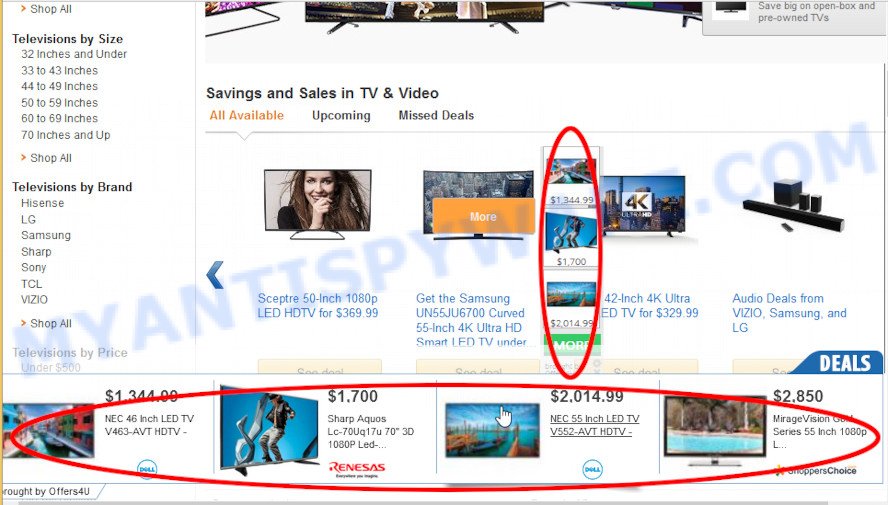
Unwanted ads
Does adware steal your confidential data? Adware has the ability to gather your surfing history and personal information, including passwords and credit card numbers. In the future, marketing-type data about you can be used for marketing purposes.
By following steps below it is easy to detect and delete unwanted ads from Chrome, Safari and Mozilla Firefox and your Apple Mac. Learn how to remove MacWebService and adware software, as well as how to run a full MAC virus scan.
How does MacWebService get on your computer
Adware gets on your MAC OS along with various free applications, as a supplement, which is installed automatically. This is certainly not an honest way to get installed onto your MAC OS. To avoid infecting of your computer and side effects in the form of numerous pop-up windows and/or intrusive ads, you should always carefully read the Terms of Use and the Software license. Additionally, always select Manual, Custom or Advanced setup mode. This allows you to disable the install of bundled and often harmful software.
Threat Summary
| Name | MacWebService, Mac Web Service 1.0 app |
| Type | adware, PUP (potentially unwanted program), pop-up virus, pop-up ads, popups |
| Symptoms |
|
| Removal | MacWebService removal guide |
How to Remove MacWebService adware software
When the adware gets installed on your Apple Mac without your knowledge, it is not easy to uninstall. In many cases, there is no Uninstall program which simply remove MacWebService from your computer. So, we recommend using well-proven free removal utility such as MalwareBytes Free. But the best method to get rid of MacWebService ads will be to perform several manual steps, after that additionally use antimalware utilities.
To remove MacWebService, execute the following steps:
- How to remove MacWebService adware software without any software
- Automatic Removal of MacWebService adware
- How to stay safe online
- Finish words
How to remove MacWebService adware software without any software
This part of the post is a step-by-step guidance that will help you to remove MacWebService adware manually. You just need to follow every step. In this case, you do not need to install any additional programs.
Deleting the MacWebService, check the list of installed applications first
First, you should try to identify and delete the program that causes the appearance of undesired advertisements or browser redirect, using the ‘Applications’ list that located in the Finder.
Open Finder and click “Applications”.
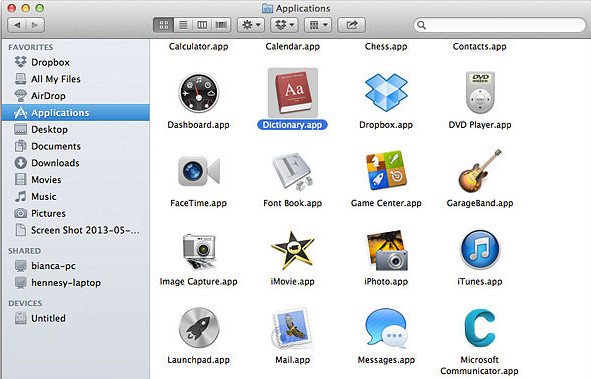
It will show a list of all programs installed on your MAC. Scroll through the all list, and remove any questionable and unknown apps. Right click to questionable program and choose “Move to Trash”. Another solution is drag the application from the Applications folder to the Trash.
Most important, scroll through the all list, and move to trash any unknown applications. Don’t forget, select Finder -> Empty Trash.
Remove MacWebService adware software from Google Chrome
Reset Google Chrome settings can help you solve some problems caused by adware and get rid of MacWebService ads from web-browser. This will also disable malicious extensions as well as clear cookies and site data. When using the reset feature, your personal information like passwords, bookmarks, browsing history and web form auto-fill data will be saved.

- First launch the Chrome and click Menu button (small button in the form of three dots).
- It will open the Google Chrome main menu. Select More Tools, then click Extensions.
- You will see the list of installed plugins. If the list has the extension labeled with “Installed by enterprise policy” or “Installed by your administrator”, then complete the following guidance: Remove Chrome extensions installed by enterprise policy.
- Now open the Chrome menu once again, press the “Settings” menu.
- You will see the Chrome’s settings page. Scroll down and click “Advanced” link.
- Scroll down again and click the “Reset” button.
- The Chrome will show the reset profile settings page as shown on the image above.
- Next click the “Reset” button.
- Once this process is finished, your browser’s search engine, startpage and new tab page will be restored to their original defaults.
- To learn more, read the blog post How to reset Google Chrome settings to default.
Get rid of MacWebService from Firefox by resetting internet browser settings
If the Firefox settings such as newtab page, default search provider and home page have been replaced by the adware, then resetting it to the default state can help. However, your themes, bookmarks, history, passwords, and web form auto-fill information will not be deleted.
First, launch the Mozilla Firefox and click ![]() button. It will open the drop-down menu on the right-part of the web browser. Further, press the Help button (
button. It will open the drop-down menu on the right-part of the web browser. Further, press the Help button (![]() ) as shown on the image below.
) as shown on the image below.

In the Help menu, select the “Troubleshooting Information” option. Another way to open the “Troubleshooting Information” screen – type “about:support” in the web-browser adress bar and press Enter. It will display the “Troubleshooting Information” page as displayed on the screen below. In the upper-right corner of this screen, click the “Refresh Firefox” button.

It will show the confirmation prompt. Further, click the “Refresh Firefox” button. The Mozilla Firefox will begin a procedure to fix your problems that caused by the MacWebService adware. After, it’s finished, click the “Finish” button.
Remove MacWebService from Safari
The Safari reset is great if your web browser is hijacked or you have unwanted add-ons or toolbars on your browser, which installed by an malware.
Run Safari internet browser. Next, select Preferences from the Safari menu.
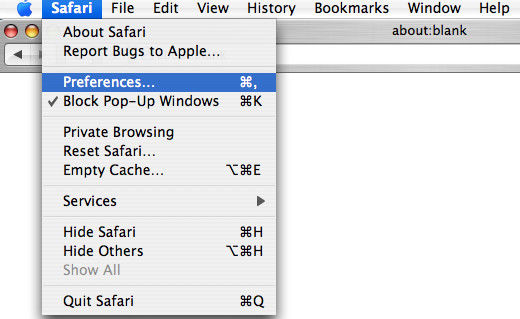
First, click the “Security” icon. Here, choose “Block pop-up windows”. It will stop some types of popups.
Now, click the “Extensions” tab. Look for dubious extensions on left panel, select it, then click the “Uninstall” button. Most important to delete all dubious extensions from Safari.
Once complete, check your home page and search engine settings. Click “General” icon. Make sure that the “Homepage” field contains the website you want or is empty.
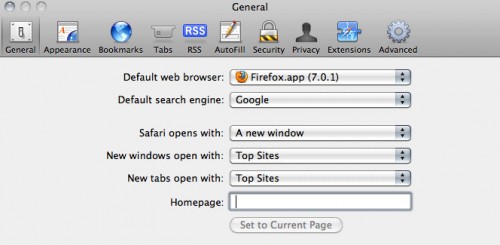
Make sure that the “Search engine” setting shows your preferred search engine. In some versions of Safari, this setting is in the “Search” tab.
Automatic Removal of MacWebService adware
Manual removal is not always as effective as you might think. Often, even the most experienced users may not completely delete MacWebService adware. So, we recommend to check your machine for any remaining harmful components with free adware removal apps below.
How to get rid of MacWebService with MalwareBytes AntiMalware (MBAM)
If you are still having problems with the MacWebService adware removal or just wish to scan your Apple Mac occasionally for adware and other malicious software, then download MalwareBytes AntiMalware (MBAM). It’s free for home use, and detects and removes various unwanted apps that attacks your MAC or degrades MAC system performance. MalwareBytes Anti Malware can get rid of hijacker, adware, PUPs as well as malware, including ransomware and trojans.
Download MalwareBytes AntiMalware (MBAM) on your computer from the link below.
21021 downloads
Author: Malwarebytes
Category: Security tools
Update: September 10, 2020
Once downloading is done, close all windows on your computer. Further, open the saved file. Follow the prompts.
The MalwareBytes AntiMalware (MBAM) will automatically run and you may see its main window as displayed on the screen below.
Next, click the “Scan Now” button to perform a system scan for the MacWebService adware. Depending on your MAC, the scan can take anywhere from a few minutes to close to an hour. When a threat is detected, the number of the security threats will change accordingly.

When that process is finished, MalwareBytes will display a list of detected threats. You may remove threats (move to Quarantine) by simply click “Remove Selected Items” button.
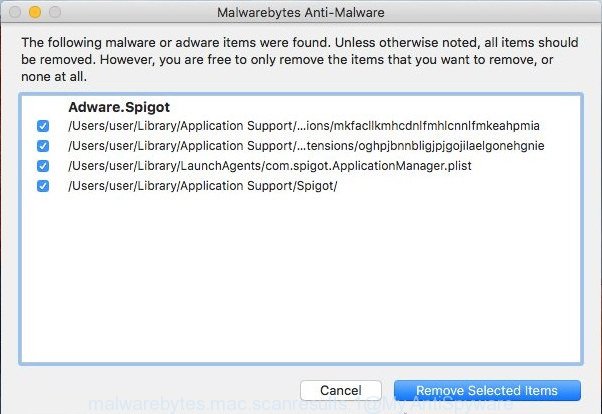
The MalwareBytes Free will delete MacWebService and move the selected threats to the Quarantine.
How to stay safe online
Use adblocker program like AdGuard in order to block ads, malvertisements, pop-ups and online trackers, avoid having to install harmful and adware browser plug-ins and add-ons which affect your computer performance and impact your machine security. Surf the Web anonymously and stay safe online!
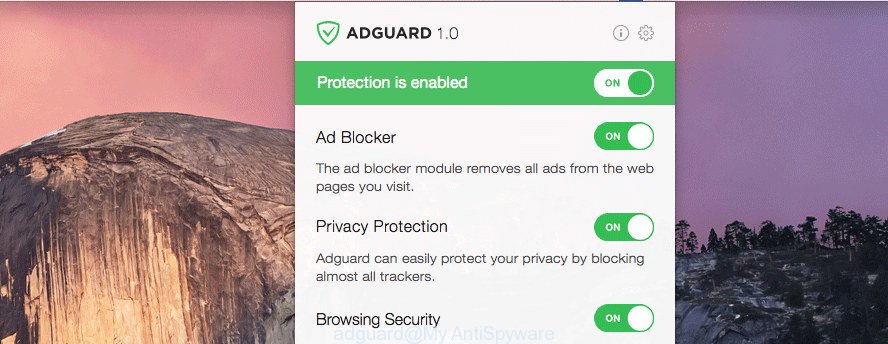
Click the link below to download AdGuard.
3782 downloads
Author: © Adguard
Category: Security tools
Update: January 17, 2018
Once downloading is complete, start the downloaded file. You will see the “Setup Wizard” screen. Follow the prompts.
Each time, when you run your MAC, AdGuard will launch automatically and stop unwanted popups, block harmful and misleading webpages.
Finish words
Once you have complete the tutorial outlined above, your MAC OS should be free from the MacWebService adware and other malicious software. The Firefox, Safari and Google Chrome will no longer display any unwanted ads. Unfortunately, if the step-by-step guide does not help you, then you have caught a new adware, and then the best way – ask for help here.

